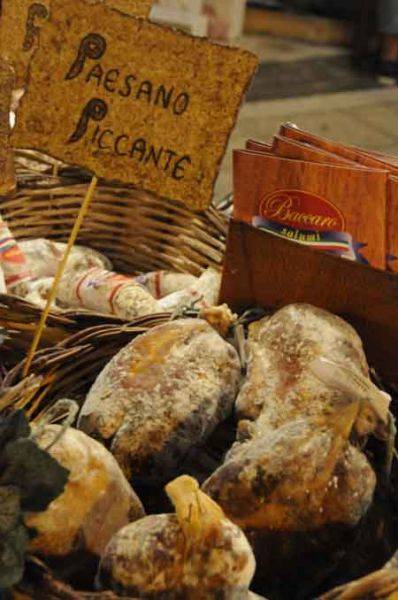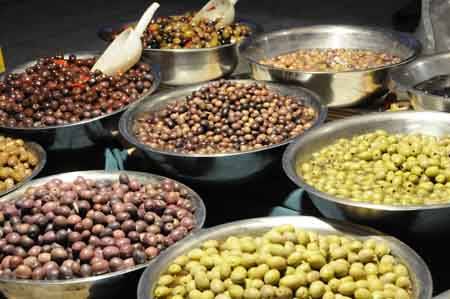The Sagra te lu Ranu Food Festival in Merine, Italy
When summer hits southern Italy, so do the wine and food festivals. Every week a new festival celebrates the crops that make this countryside beautiful and supply many with their livelihood. The Sagra te lu Ranu festival in Merime, a town on the Salento peninsula in the Puglia region, can be viewed as more of a worship than a celebration. Taking place in the spring, it focuses on the harvest to come and the elements of nature that give the land its incredible fertility, by featuring traditional delicacies such as raw and aged cheeses, cured meats, wines, grappa, and breads and pastas made from locally grown durum wheat.
The history of Pugliese cuisine is marked by an inventiveness born of poverty, and many of the dishes utilize less-appreciated parts of fruits and vegetables, such as the pomace (grape skins and stems left over from the wine-making process) used to create grappa, or leftovers, such as fried breadcrumbs made from day-old bread as a substitution for cheese over pasta. Most of Puglia’s dishes cannot be found anywhere else in the world, though they exhibit a plethora of outside influences. This is to be expected of a land that has so often changed hands. Even at the
beginning of the 1900s, Greek was commonly spoken.
Puglia is the flattest part of Italy, and it naturally lends itself to growing most of Italy’s durum wheat, the wheat most commonly used to make dried pasta. Two-thirds of all of Italy’s olive oil is also produced in Puglia, and it is of exceptional quality. A particularly unique ingredient found in Pugliese kitchens is lampascioni, or hyacinth bulbs, recipes for which are featured prevalently in local magazines and newspapers. Cleaning and preparing them is difficult and time consuming. Add that to their distinct, bitter taste and it is understandable why few other cultures eat them. However, they are now viewed as one of the dishes that define Puglia’s unique culinary history, and they provide a unique experience for food experimentalists. Another peculiarity of Puglia is barattiere, a vegetable that is found nowhere else on earth. Depending on which time of year it is eaten, it resembles either a cucumber or a melon.
The Sagra te lu Ranu festival took place July 10th-12th and showcased several of Puglia’s most popular foods. Wine and beer stands were also set up. A plastic cup of local wine ran fifty centesimi (euro cents). The town of Merine was decorated with hay bales from the surrounding fields, and many private homes set up displays that centered on their agricultural heritage. Right now, the Puglia countryside features rolling hills of sunflowers that extend as far as the eye can see, and these sunflowers were also used for decorations.
Popular hand-held snacks include rustici, which are round, flaky, savory pastries filled with cheese, tomato sauce, and a sauce similar to béchamel, and pizzi, something between a biscuit and a pizza, the dough made from a combination of potato and wheat with tomatoes, onions, and olives mixed in. Calzones are also popular, and they differ from those found in the north. Puglia’s calzones are deep-fried and nothing beats the first, doughy bite as it releases the scent of the mozzarella and tomato sauce inside. Friseddhe is native to Lecce, the capital city of the Lecce region in Puglia, and is a unique take on bruschetta. The bread is made from barley or wheat flour and baked twice, making it long lasting. It is usually topped with a tomato, onion, and basil mixture; the version at Sagra te lu Ranu included slices of grilled calamari and anchovies as well.
For the main courses, the festival offered fresh pastas made from local grain and hearty bean-focused plates. Muersi is a sturdy mash—inspired by leftovers—of beans, peas, broccoli raab, and fried bread. The broccoli raab imparted its strong flavor but was not bitter. I have never had broccoli raab cooked as well as in the kitchens of Puglia. The trick is to boil it just long enough to let the bitterness out without losing the firm texture, maybe 5-6 minutes. A little-known fact is that broccoli raab is not part of the Brassicaceae family, as is broccoli, but part of the Brassica rapa, better known as the turnip family. Fresh orecchiette was also served, the pasta Puglia is best known for, the name of which means “little ears.” To accompany the fresh pasta, a selection of raw local cheese (aged less than 60 days), cacio ricotta, pecorino cheese, breadcrumbs, hot peppers, and two tomato sauces were offered.
To finish it all off, the festival offered pasticiotti and grappa. A pasticiotto is a sweet pastry that the Puglia region is known for: a pastry similar to shortbread that is wrapped around a crème or lemon-crème filling. Freshly baked, they are how most Southern Italians begin their morning. Those at the festival were provided by Pasticceri Salentini.
Grappa is a strong spirit made from pomace. The purists prefer it aged in stainless steel while others age it in oak. The latter version is reminiscent of Scotch. The grappa was provided by Tenuta Verola (insert: http://www.tenutaverola.it/), who featured both dry and sweet grappas made from the region’s best-known grapes: Negroamaro, Malvasia Nera, and Aleatico. The sweet grappas featured a range of flavors, from almond and lemon to myrtle and black cherry. I preferred the dry, two of which were technically Acquavite, a higher-quality grappa made from whole grapes. My favorite of Tenute Verola’s offerings was the Acquavita made from Aleatico grapes. It was well balanced and complex.
I left the festival feeling warm, not only from the grappa, but from the wonderful energy of the people. From the youngest to the oldest, everyone wanted to be in my photographs and to know where I was from. When I said California, many responded by commenting on how beautiful California is. I certainly agree that California is beautiful—as is Puglia, whose history of poverty is eclipsed by its seaside cliffs, turquoise waters, white sands, and rich culinary tradition, raising the important question: By what, is wealth measured?





































i-Italy
Facebook
Google+
This work may not be reproduced, in whole or in part, without prior written permission.
Questo lavoro non può essere riprodotto, in tutto o in parte, senza permesso scritto.